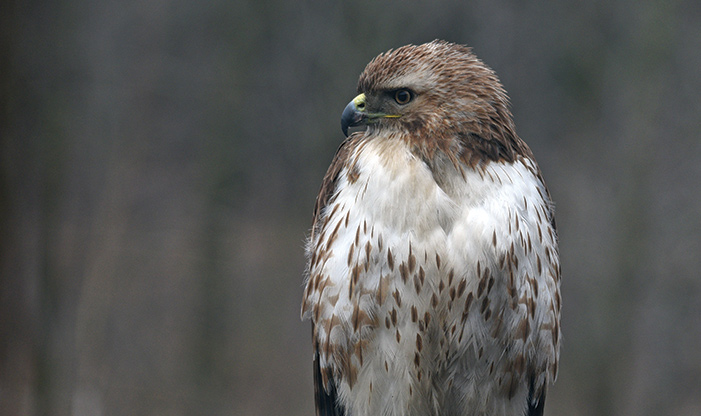Red-tailed Hawks (Buteo jamaicensis) are the most common raptors in Wisconsin and in North America. They adapt well to almost any environment and live in areas that are wide open, like grasslands and prairies, parks, deserts, and even roadsides. Because they are opportunistic hunters, they are well suited to urban areas.
How to Identify Red-tailed Hawks
This species is named for the cinnamon-red tail of an adult. However, this feather color does not emerge until after more than a year of life and the bird has molted into its adult plumage. In addition, there are regional differences in Red-tailed Hawks’ feather coloration. This often makes them difficult to identify, even to the most knowledgeable birdwatcher.
Juvenile Red-tailed Hawks have a tail that is longer and striped with brown. These different tail colors and shapes aid the young birds in three ways: the longer tails are easier to maneuver as the bird learns to fly, the colors are better for camouflage, and it signifies to adults that they are not ready to mate or hold territory. When they molt in their red tail, those benefits are foregone.
Some individuals are identified by their morph, or color, and are sometimes considered a subspecies of Red-tailed Hawks. However, all adult Red-tailed Hawks have that famous red tail in some capacity, and are classified under the Buteo genus for “soaring hawks.” One way to identify a Red-tailed Hawk is to look at the bird in sunlight; the bright red tail will look like it is glowing.
Flight and Sight
All species in this genus have broad wings and a widespread tail that allows them to effectively use warm air thermals to soar. These adaptations save them the energy of flapping, but also restrict them to activity during the day when warm air thermals to soar on are strongest.
Their incredible eyesight allows them to scan open areas for their favorite prey items. Red-tailed Hawks have vision much more acute than humans; some scientists have said that they can spot their moving prey from a mile away. These raptors can also see light from the UV spectrum, which humans cannot do. This means that these hawks can perceive colors we can’t even dream of!
Their acute eyesight, in addition to sharp talons, helps them hunt and catch their prey. They eat animals such as voles, mice, wood rabbits, and ground squirrels. They also eat other birds and snakes, and are able to carry prey up to half of their body weight. Red-tailed Hawks use a hunting method called perch and pounce, perching on a branch until their prey appears, and then pouncing quickly to catch it.
Where Red-tailed Hawks Nest
The same characteristics that help the birds hunt also help them defend their territory and nests. Red-tailed Hawks make new nests or reuse already made ones, building them in areas that have a good view, like tall trees and cliff ledges, or on artificial structures like billboards. They are made of dry sticks and are lined with bark, foliage, and dry vegetation. Nest structures are large; around six feet high, three feet wide, and when the birds’ brood, will hold from one to five eggs.
If you want to see Red-tailed Hawks in the wild, you don’t have to look very far. The prairies at Schlitz Audubon are home to many of these raptors, where they can soar overhead and scan for a tasty meal. And, the next time you’re driving, take a quick glance on the tops of light poles for Red-tails scanning the roadsides!
Schlitz Audubon’s Raptor Program has a resident 20-year-old Red-tailed Hawk named Sky Walker. As a young bird, she found her way into a family’s backyard. The family recognized that she needed help, and took her to a wildlife rehabilitator. It was determined that she lacked the skills to survive in the wild, and she was deemed imprinted on humans. So, she now lives at the Center as an educational ambassador!


